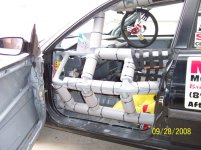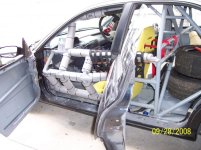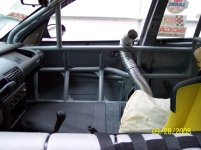I know we've hashed this out here in the past; I tried to find the relevant topics but could not. However, we had one hell of a troubling incident this weekend that I wanted to relate, and to caution.
At yesterday's NARRC Runoffs at LRP, ITA Integra driver Richie Hunter spun in West Bend, a very fast sweeper corner leading up to the bridge. He stopped driver's right (normal line is driver's left), with the passenger side of the car facing oncoming traffic and the two front wheels in the grass. As he sat there, perpendicular to the traffic, two or more cars passed by safely before another car t-boned him directly in the middle of the passenger door.
For reference, most fast ITA cars are going about 80-85 through that section.
The damage was sobering. Richie managed to drive the drive the car back into the pits, but you could hear a pin drop except for the mass sharp inhales and "oh my gods" and "holy shits" as he drove by: his passenger door was COMPLETELY driven into the car, bent in half, and up against the exhaust tunnel and his right arm. A casual observer would note the right door was simply missing altogether.
Richie's OK; he got his bell rung good, and he said he was momentarily knocked unconscious (I think he was just knocked silly, but it's really hard to tell with him anyway...) He also complained of right arm pain, but he's been checked out and I personally saw him as we were packing up and he looks fine.
But post-race we all got a good look at the car. As described the door was completely destroyed, hammered well into the car. The passenger-side rollcage/intrusion protection had completely failed.
Richie had the venerable "X" bar on the passenger side, one diagonal tube, with two other tubes welded to that to make an "X". That structure failed. Your first thought is probably that the welds failed, but you would be wrong: all welds seemed to hold. The primarily structural failure was on the first main diagonal bar, which simple tore apart at its center in tension. Then, the two triangular "halves" of the X-bar system hinged inwards where they were welded to the main the front hoops, tearing the two tubes partially off. To imagine this, think of the old Western saloon doors that swing to each side; the X-bar tube separated in the center, then allowed the other car to penetrate in the middle, tearing each half at the vertical tubes they were attached to. The door then came off of its hinges and latches, bending as it penetrated through the "swinging door".
The forces of the crash were so hard that the main hoop, front legs, and main plane diagonal bar were bent as well.
And lest you think this was some big heavy car, it was a Miata, I believe a SMMAITAC. So, what, 2380#...?
Similarly to my Watkins Glen incident two weeks ago, the Miata punched right through the center of the door, almost leaving the rocker panel completely intact. Because of the design of the nose of the Miata and the significant lowering one can do with an Integra, the main side structure of the car, the rocker panel, was ineffective at providing crash protection.
I bring up this subject as a point of interest for current and future builds. I've been a proponent of the X-bar system in the past, as I believe a well-built one can work. However, this incident was sobering. Richie has the "standard" multi-tubes-with-verticals-NASCAR-bars on the driver's side, but for that and 180 degrees of rotation I firmly believe Richie would not be alive today. I certainly could not see a passenger surviving a crash like this on the street: there was just no place for a breathing human to be.
From this I take three main points.
First, the basic x-bar system by itself may not be adequate. Since there is only one whole diagonal bar in that design the tensile forces are only resisted by one tube. I would recommend one of two directions if you pursue the X-bar: either bend two tubes in "U" shape and weld them together at the center, or weld plates completely across the intersection to increase the cross-sectional area of the main point of tension. Or both. I've linked a (poor) photo of our Integra from the Watkins Glen wreck to demonstrate what I mean.
Second, creating a single-plane x-bar is probably not a good idea. This x-bar is subjected to bending and tensile forces; tubing works better in compression. If this x-bar had extended outwards in a "pup tent" type of fashion into the door, it may have withstood the punching forces better.
Third, we need to give serious consideration to design based on who we race with. As noted, the only thing between Richie and the nose of that Miata was his factory door and his rollcage x-bar. The 'Teg's rocker panel was nothing more than a footnote in that crash, as the Miata with its shark nose drove up and over it.
Finally (yes, I know this is four), there was door glass everywhere inside that car. Richie got showered by it. I am a clear proponent now of recommending - possibly requiring - removal of door glass. Fortunately, Richie was wearing a face shield with eye protection.
We have no photos, at Richie's request. But I hope I've described this satisfactorily to you. This si something we need to hash over; while I hope no one is subjected to this in the past, we need to prepare for it.
Greg

At yesterday's NARRC Runoffs at LRP, ITA Integra driver Richie Hunter spun in West Bend, a very fast sweeper corner leading up to the bridge. He stopped driver's right (normal line is driver's left), with the passenger side of the car facing oncoming traffic and the two front wheels in the grass. As he sat there, perpendicular to the traffic, two or more cars passed by safely before another car t-boned him directly in the middle of the passenger door.
For reference, most fast ITA cars are going about 80-85 through that section.
The damage was sobering. Richie managed to drive the drive the car back into the pits, but you could hear a pin drop except for the mass sharp inhales and "oh my gods" and "holy shits" as he drove by: his passenger door was COMPLETELY driven into the car, bent in half, and up against the exhaust tunnel and his right arm. A casual observer would note the right door was simply missing altogether.
Richie's OK; he got his bell rung good, and he said he was momentarily knocked unconscious (I think he was just knocked silly, but it's really hard to tell with him anyway...) He also complained of right arm pain, but he's been checked out and I personally saw him as we were packing up and he looks fine.
But post-race we all got a good look at the car. As described the door was completely destroyed, hammered well into the car. The passenger-side rollcage/intrusion protection had completely failed.
Richie had the venerable "X" bar on the passenger side, one diagonal tube, with two other tubes welded to that to make an "X". That structure failed. Your first thought is probably that the welds failed, but you would be wrong: all welds seemed to hold. The primarily structural failure was on the first main diagonal bar, which simple tore apart at its center in tension. Then, the two triangular "halves" of the X-bar system hinged inwards where they were welded to the main the front hoops, tearing the two tubes partially off. To imagine this, think of the old Western saloon doors that swing to each side; the X-bar tube separated in the center, then allowed the other car to penetrate in the middle, tearing each half at the vertical tubes they were attached to. The door then came off of its hinges and latches, bending as it penetrated through the "swinging door".
The forces of the crash were so hard that the main hoop, front legs, and main plane diagonal bar were bent as well.
And lest you think this was some big heavy car, it was a Miata, I believe a SMMAITAC. So, what, 2380#...?
Similarly to my Watkins Glen incident two weeks ago, the Miata punched right through the center of the door, almost leaving the rocker panel completely intact. Because of the design of the nose of the Miata and the significant lowering one can do with an Integra, the main side structure of the car, the rocker panel, was ineffective at providing crash protection.
I bring up this subject as a point of interest for current and future builds. I've been a proponent of the X-bar system in the past, as I believe a well-built one can work. However, this incident was sobering. Richie has the "standard" multi-tubes-with-verticals-NASCAR-bars on the driver's side, but for that and 180 degrees of rotation I firmly believe Richie would not be alive today. I certainly could not see a passenger surviving a crash like this on the street: there was just no place for a breathing human to be.
From this I take three main points.
First, the basic x-bar system by itself may not be adequate. Since there is only one whole diagonal bar in that design the tensile forces are only resisted by one tube. I would recommend one of two directions if you pursue the X-bar: either bend two tubes in "U" shape and weld them together at the center, or weld plates completely across the intersection to increase the cross-sectional area of the main point of tension. Or both. I've linked a (poor) photo of our Integra from the Watkins Glen wreck to demonstrate what I mean.
Second, creating a single-plane x-bar is probably not a good idea. This x-bar is subjected to bending and tensile forces; tubing works better in compression. If this x-bar had extended outwards in a "pup tent" type of fashion into the door, it may have withstood the punching forces better.
Third, we need to give serious consideration to design based on who we race with. As noted, the only thing between Richie and the nose of that Miata was his factory door and his rollcage x-bar. The 'Teg's rocker panel was nothing more than a footnote in that crash, as the Miata with its shark nose drove up and over it.
Finally (yes, I know this is four), there was door glass everywhere inside that car. Richie got showered by it. I am a clear proponent now of recommending - possibly requiring - removal of door glass. Fortunately, Richie was wearing a face shield with eye protection.
We have no photos, at Richie's request. But I hope I've described this satisfactorily to you. This si something we need to hash over; while I hope no one is subjected to this in the past, we need to prepare for it.
Greg
Last edited:










